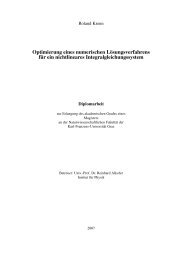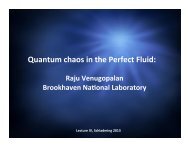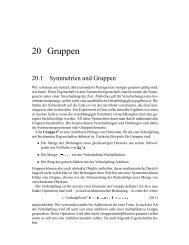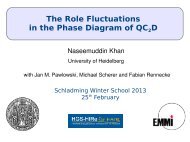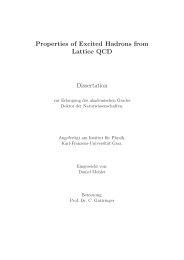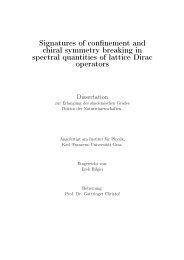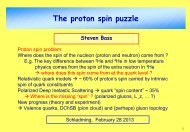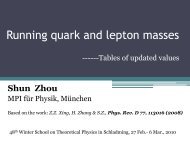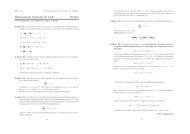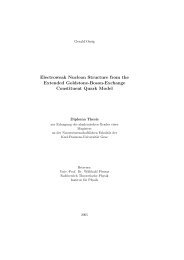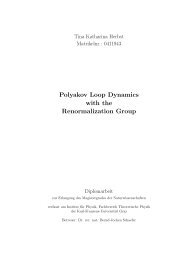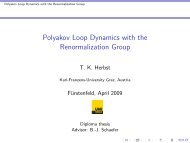The QCD Quark Propagator in Coulomb Gauge and - Institut für Physik
The QCD Quark Propagator in Coulomb Gauge and - Institut für Physik
The QCD Quark Propagator in Coulomb Gauge and - Institut für Physik
Create successful ePaper yourself
Turn your PDF publications into a flip-book with our unique Google optimized e-Paper software.
Chapter 6. Nucleon Form Factors <strong>in</strong> a Covariant Diquark-<strong>Quark</strong> model 87<br />
Q 2 F 2p<br />
/(κ p<br />
F 1p<br />
)<br />
Q F 2p<br />
/(κ p<br />
F 1p<br />
)<br />
3.0<br />
2.0<br />
1.0<br />
0.0<br />
0.9<br />
0.6<br />
0.3<br />
set A<br />
set B<br />
SLAC<br />
JLab1<br />
JLab2<br />
0<br />
0 1 2 3 4 5 6<br />
Q 2 [GeV 2 ]<br />
Figure 6.7: Proton Pauli/Dirac form factor ratios, cf. [AHK + 05]. <strong>The</strong> data are as described<br />
<strong>in</strong> figure6.5, as are the b<strong>and</strong>s except that here the upper border is obta<strong>in</strong>ed with µ 1 + = 1,<br />
χ 1 + = 1 <strong>and</strong> κ T = 2, <strong>and</strong> the lower with µ 1 + = 3.<br />
ultraviolet momenta [MR98]. <strong>The</strong>se components are required by covariance [MRT98] <strong>and</strong><br />
signal the presence of quark orbital angular momentum <strong>in</strong> the pseudoscalar pion.<br />
In figure 6.9 we plot another weighted ratio of Pauli <strong>and</strong> Dirac form factors. A perturbative<br />
<strong>QCD</strong> analysis [BJY03] that considers effects aris<strong>in</strong>g from both the proton’s lead<strong>in</strong>g<strong>and</strong><br />
sublead<strong>in</strong>g-twist light-cone wave functions, the latter of which represents quarks with<br />
one unit of orbital angular momentum, suggests<br />
Q 2<br />
[ln Q 2 /Λ 2 ] 2 F 2 (Q 2 )<br />
F 1 (Q 2 ) = constant, Q2 ≫ Λ 2 , (6.100)<br />
where Λ is a mass-scale that corresponds to an upper-bound on the doma<strong>in</strong> of nonperturbative<br />
(soft) momenta. This scal<strong>in</strong>g hypothesis is not predictive unless the value of Λ is<br />
known a priori. However, Λ cannot be computed <strong>in</strong> perturbation theory.<br />
A scale of this type is not an elemental <strong>in</strong>put to our calculation. It is <strong>in</strong>stead a<br />
derivative quantity that expresses the net <strong>in</strong>tegrated effect of many basic features, among<br />
which are the mass-scale characteris<strong>in</strong>g quark-dress<strong>in</strong>g <strong>and</strong> that implicit <strong>in</strong> the support<br />
of the Faddeev amplitude. Extend<strong>in</strong>g our calculation to larger Q 2 is not a problem <strong>in</strong>



